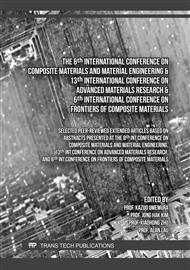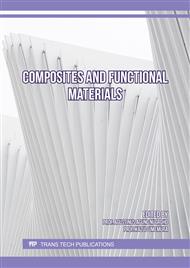[1]
J. L. Johnson: Met. Hard Mater. Vol. 53(Pt. B) (2015), p.80.
Google Scholar
[2]
A. Sun, D. Wang, Z. Wu and X. Zan: J. All. Comp. Vol. 505(2) (2010), p.588.
Google Scholar
[3]
J. T. Yao, C. J. Li, L. Yi, B. Chen and H. B. Huo: Mater. Des. Vol. 88(DEC.25) (2015), p.774.
Google Scholar
[4]
G. S. Jiang, Z. F. Wang, Y. Gu and J. W. Liu: Rare Met. Mater. Eng. Vol. 41(1) (2012), p.161, in Chinese.
Google Scholar
[5]
D. Z. Wang, X. J. Dong, P. Zhou, A. K. Sun and B. H. Duan: Int. J. Refract. Met. Hard Mater. Vol. 42 (2014), p.240.
Google Scholar
[6]
X. P. Ji, W. C. Cao, C. Y. Bu, Y. D. Wu and G. H. Zhang: Int. J. Refract. Met. Hard Mater. Vol. 81 (2019), p.196.
Google Scholar
[7]
A. B. Paola, S. Benjamin and H. P. Rodrigo: Mater. Sci. Eng. A Vol. 701 (2017), p.237.
Google Scholar
[8]
S. V. Aydinyan, H. V. Kirakosyan and S. L. Kharatyan: Int. J. Refract. Met. Hard Mater. Vol. 54 (2016), p.455.
Google Scholar
[9]
D. Z. Wang, Y. Q. Zhang and B. H. Duan: Non. Met. Sci. Eng. Vol. 9(3) (2018), p.11, in Chinese.
Google Scholar
[10]
T. Minasyan, H. Kirakosyan, S Aydinyan, L. Liu, S. Kharatyan and I. Hussainova: J. Mater. Sci. Vol. 53 (2018), p.16598.
DOI: 10.1007/s10853-018-2787-1
Google Scholar
[11]
O. V. Belay and S. P. Kiselev: Phys. Mesomech. Vol. 14(3-4) (2011), p.145.
Google Scholar
[12]
S. L. Han, Y. X. Cai, Y. Q. Song and S. Cui: Rare Met. Mater. Eng. Vol. 39(6) (2010), p.989.
Google Scholar
[13]
V. Tsakiris, E. Enescu, M. Lungu, M. Lucaci and I. Ioana: International Symposium on Advanced Topics in Electrical Engineering IEEE (2015), p.490.
DOI: 10.1109/atee.2015.7133851
Google Scholar
[14]
Z. F. Li, H. Y. Liu, A. J. Li, H. L. Zhang, Y. P. Huang and Y. Shi: Adv. Mater. Res. Vol. 873 (2014), p.67.
Google Scholar
[15]
I. Zhirkov, A. Petruhins, P. Polcik, S. Kolozsvari and J. Rosen: Appl. Phys. Let. Vol. 108(5) (2016), p.73.
Google Scholar
[16]
X. H. Zhou, Y. H. Yang, X. S. Gong and S. J. Yong: Ord. Mater. Sci. Eng. Vol. 38(3) (2015), p.48, in Chinese.
Google Scholar
[17]
O. C. Sang, D. Klein, H. Liao, L. Dembinski and C. Coddet: Sur. Coat. Tec. Vol. 200(21-22) (2006), p.5682.
Google Scholar
[18]
A. K. Sun, Y. J. Liu and Q. R. Chen: J. Mater. Eng. Vol. 47(1) (2019), p.112.
Google Scholar
[19]
J. Li, G. S. Jiang, S. Zhang and Z. F. Wang: Mater. Sci. Eng. Powd. Metall. Vol. 21(4) (2016), p.610, in Chinese.
Google Scholar
[20]
J. F. Wang, C. Y. Bu, K. He, X. P. Ji, H. Zhang, G. H. Zhang and G. Z. Zhou: Alloys, Pow. Metall. Tec. Vol. 39(1) (2021), p.24, in Chinese.
Google Scholar
[21]
C. L. Sun: The Study on Preparation and Properties of Mo-20wt. %Cu Composites (Xi'an University of Technology, Chinese 2019).
Google Scholar
[22]
A. Kumar, K. Jayasankar, M. Debata and A. Mandal: J. All. Comp. Vol. 647 (2015), p.1040.
Google Scholar
[23]
Z. H. Cao, X. R. Jin, T. Li and J. Y. Zeng: Elec. Eng. Mater. Vol. 2 (2021), p.3, in Chinese.
Google Scholar
[24]
X. J. Zheng, W. B. Fan and F. Xue: Nonferrous. Met. Eng. Vol. 10(8) (2020), p.1, in Chinese.
Google Scholar
[25]
L. Shi: Study on Activated Sintering Technology of Molybdenum Copper Alloy (Harbin University of Science and Technology, Chinese 2020).
Google Scholar
[26]
U. Mizutani: Hume-rothery Rules for Structurally Complex Alloy Phases (CSC Press, Boca Raton 2010).
DOI: 10.1201/b10324
Google Scholar
[27]
S. Ke, K. Feng, H. Zhou and Y. Shui: J. All. Comp. Vol. 775 (2019), p.784.
Google Scholar
[28]
J. Du, H. Yuan. X. Chan and Y. Liu: J. Mater. Sci. Tec. Vol. 34(4) (2018), p.689.
Google Scholar
[29]
R. M. German: Metall. Mater. Transa. A Vol. 24(8) (1993), p.1746.
Google Scholar
[30]
D. S. McLachlan, M. Blaszkiewicz and R. E. Newnham: J. Am. Chem. Soc. Vol. 73(8) (1990), p.2187.
Google Scholar
[31]
X. Chen, H. Zhang and G. Zhao: J. Mater. Eng. Per. Vol. 31(3) (2022), p.2551.
Google Scholar
[32]
S. Liu, M. Xu, T. R. Li, G. H. Liu, Z. D. Wang and G. D: Rare Met. Mater. Eng. Vol. 50(9) (2021), p.3203.
Google Scholar
[33]
Y. Pan: J. Mater. Eng. Per. Vol. 30(4) (2021), p.2661.
Google Scholar
[34]
T.C. Zou, M. Y. Chen, H. Zhu and S. Y. Mei: J. Mater. Eng. Per. Vol. 31(3) (2022), p.1791.
Google Scholar



